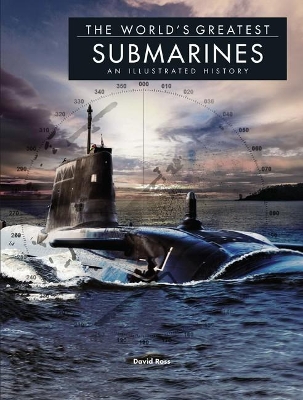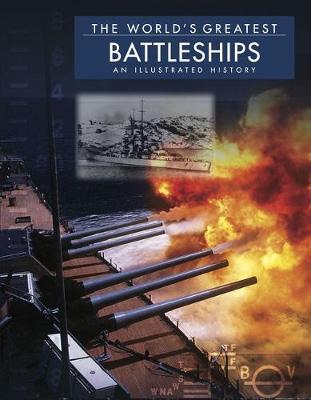The World's Greatest
3 total works
In 1776, American Patriots attempted to destroy the British flagship Eagle using a man-operated semi-submersible, the Turtle, in New York harbour. The attack failed, but the idea stuck. Almost 90 years later, the CSS Hunley successfully rammed into the Federal sloop USS Housatonic with a spar torpedo. The Housatonic became the first ship in naval history to be sunk by a submarine.
The World’s Greatest Submarines features the most significant submarines built, from the German U-9 – which sank three British cruisers on 22 September 1914 – through the huge Japanese I-400 class to the great nuclear-powered submarines of the Cold War, such as the USS Los Angeles and Soviet Oscar class. Also included are the ‘undersea cruiser’ Surcouf; the highly successful Type VII U-boats of World War II; and the latest attack and ballistic missile submarines, such as HMS Astute, USS Virginia, the Chinese Type 094 and the Russian Yasen class.
Each entry includes a brief description of the submarine’s development and history, a colour profile or cutaway, key features and specifications. Packed with more than 200 artworks and photographs, The World’s Greatest Submarines is an accessible guide for those interested in naval history.
The World’s Greatest Submarines features the most significant submarines built, from the German U-9 – which sank three British cruisers on 22 September 1914 – through the huge Japanese I-400 class to the great nuclear-powered submarines of the Cold War, such as the USS Los Angeles and Soviet Oscar class. Also included are the ‘undersea cruiser’ Surcouf; the highly successful Type VII U-boats of World War II; and the latest attack and ballistic missile submarines, such as HMS Astute, USS Virginia, the Chinese Type 094 and the Russian Yasen class.
Each entry includes a brief description of the submarine’s development and history, a colour profile or cutaway, key features and specifications. Packed with more than 200 artworks and photographs, The World’s Greatest Submarines is an accessible guide for those interested in naval history.
From the English Henry Grace à Dieu in 1514 to the 1950s’ Vanguard battlecruiser, The World’s Greatest Battleships celebrates 50 of the most remarkable battleships and battlecruisers across 500 years of history.
Spanning numerous conflicts, including the Seven Years’War, the Napoleonic Wars, World War I, World War II, the Cold War and First Gulf War, classics such as Victory, Dreadnought, Bismarck and Yamato are included.
Each featured ship is presented with an annotated full colour profile artwork, expert background text on its development and service history and full technical specifications. Splendidly illustrated and authoritatively written, The World’s Greatest Battleships is an essential companion for anyone interested in naval history.
Spanning numerous conflicts, including the Seven Years’War, the Napoleonic Wars, World War I, World War II, the Cold War and First Gulf War, classics such as Victory, Dreadnought, Bismarck and Yamato are included.
Each featured ship is presented with an annotated full colour profile artwork, expert background text on its development and service history and full technical specifications. Splendidly illustrated and authoritatively written, The World’s Greatest Battleships is an essential companion for anyone interested in naval history.
On 9 May 1912 the first airplane take-off from a ship was made from the deck of the HMS Hibernia. In July 1918, seven Sopwith Camels launched from the converted battlecruiser HMS Furious damaged the German airbase at Tønder and destroyed two zeppelins. The age of the carrier was born. In the interwar years the Lexington, Akagi and Courageous class carriers were developed, but it was only during World War II that the aircraft carrier finally came into its own. Fleet carriers carrying 30–40 aircraft allowed the Japanese and US navies to project air power across the vast Pacific Ocean, with the Japanese raid on Pearl Harbor presaging a new kind of warfare. With the sinking of hundreds of ships during World War II, including the German battleship Bismarck in 1941, by the end of the war carriers ruled the waves and the era of the battleship had passed.
The World’s Greatest Aircraft Carriers features 52 of the most significant flat tops and amphibious assault ships built since the 1920s until the present day, from the USS Yorktown, which survived direct hits during the battle of Midway (1942), through the Falklands War veteran HMS Invincible, to the mighty Nimitz class, the core of the US Navy’s carrier battle groups today. Also included are significant amphibious assault ships, such as the USS Tarawa and French Mistral.
Each entry includes a brief description of the ship’s development and history, a colour profile view or cutaway, key features and specifications. Packed with more than 200 artworks and photographs, The World’s Greatest Aircraft Carriers is a colourful guide for the naval warfare enthusiast.
The World’s Greatest Aircraft Carriers features 52 of the most significant flat tops and amphibious assault ships built since the 1920s until the present day, from the USS Yorktown, which survived direct hits during the battle of Midway (1942), through the Falklands War veteran HMS Invincible, to the mighty Nimitz class, the core of the US Navy’s carrier battle groups today. Also included are significant amphibious assault ships, such as the USS Tarawa and French Mistral.
Each entry includes a brief description of the ship’s development and history, a colour profile view or cutaway, key features and specifications. Packed with more than 200 artworks and photographs, The World’s Greatest Aircraft Carriers is a colourful guide for the naval warfare enthusiast.


